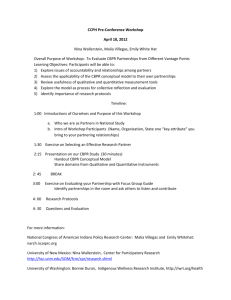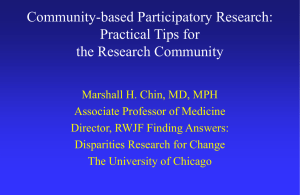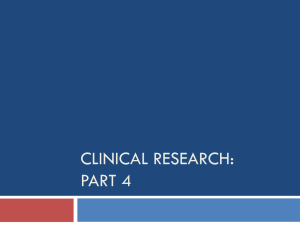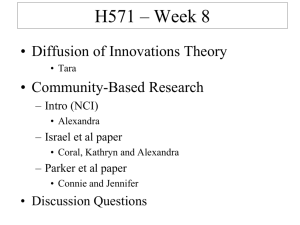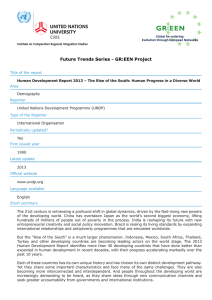15-502 Technology and Global Development Instructors: TA:
advertisement
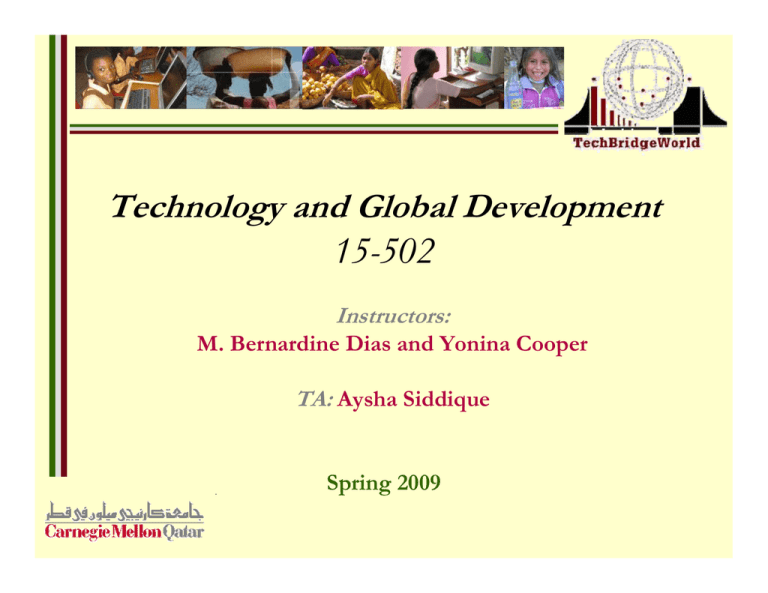
Technology and Global Development 15-502 Instructors: M. Bernardine Dias and Yonina Cooper TA: Aysha Siddique Spring 2009 Lecture 6 Capacity Building II Outline • • • Logistics Capacity building Your assignments for next week Logistics • New student plan • Research assignment reminder • Questions about the media and campaign assignments? • Movie night? • Any other questions/comments? Problem Solving • Identify the problem • Understand the problem – Start with the big picture – Drill down for details – Different perspectives? • Potentially decompose the problem into smaller parts – Always keep in mind how the component problems relate to the larger one • Identify the requirements and constraints of the problem • Define your role in solving the problem • Design a solution – Research related work – Don’t reinvent the wheel • Test and validate the solution • Deploy the solution Capacity Building Video Discussion • • • • • • • • • • What were some of the problems with the way water was supplied to the villagers at the beginning of film? How was clean water brought to the village? What problems (and for whom) arose with this solution? Why did this solution fail? Who initiated finding out why the project failed (i.e. why the pumps were not repaired)? What were the problems? Why was there no resolution to these problems? Who initiated a possible solution to broken pumps in Ayole? What were the attitudes (initially) of the workers sent in to facilitate helping the villagers have clean water? What were the attitudes of the villagers? Identify the stakeholders in the second solution. What was the role of each? Why was this solution successful? What were other benefits resulting (than clean water) from this solution? Development Gateway • Development Gateway Foundation is an international nonprofit organization with the mission to reduce poverty and enable change in developing nations through information technology. • Development Gateway Foundation provides Web-based platforms that make aid and development efforts more effective around the world. • Focus resources in three areas where even small investments in information and communications technology (ICT) can make a major difference: – Effective government – enabling better aid management and coordination, and more efficient and transparent government procurement. – Knowledge sharing and collaboration – leveraging the Internet for online communications among development practitioners worldwide. – Local partner programs in nearly 50 countries – connecting developing country organizations into our mission and helping empower them to use ICT to scale up local development efforts. • Development Gateway Foundation has an online resources portal for development information and knowledge-sharing worldwide. – The tools on this website bring together people and organizations around the globe who are working to improve life in developing countries. http://www.developmentgateway.com Capacity Building/Development • The UNDP: – Strengthens institutions to empower the citizens they serve – Supports institutions that safeguard political and economic stability – Promotes the equitable distribution of resources – Increases public transparency and accountability – Enhances the conditions for sustainable human development – Forges relevant partnerships • The key is to empower people to help themselves • Sustainability is crucial http://www.undp.org/publications/annualreport2008/pdf/IAR2008_ENG_low.pdf Reading Discussion • • • • • • • • How did the state of the government in Bangladesh affect the establishing of the Grameen Bank? Who was A. M. A. Muhith? What role did he play in helping Yunus establish the Grameen Bank? Was the bank established as envisioned by Yunus? What were the differences in the bank created and the one Yunus desired? Were all the problems ultimately resolved to Yunus’ liking? What was Muhith’s promise regarding the bank? Was he able to keep his promise? Why or why not? What lessons can you take away from Yunus’ experiences in the establishment of the Grameen Bank? What did you learn from the pictures? Was this capacity building? Why or why not? Capacity Building Examples • Are each of these examples of capacity building? Why or why not? – In Niger, UNDP helped create a corps of local volunteers in a UNVsupported national volunteerism scheme. Among the first clients of the initial 100 recruits were newly elected administrators in rural areas of Niger, who turned to their compatriots in seeking practical expertise in delivering public services. – In Jordan, UNDP worked with the Government to devise a sustainable mine action strategy that allowed Jordan to meet its obligations under the international Mine Ban Convention. Among the cleared locations were the southern area of Wadi Araba, the site of massive foreign investment in the tourism sector, and the Jordan Valley, home to many of Jordan’s poorest communities. – In Albania, UNDP supported the creation of an online ‘braingain’ database to allow skilled emigrants from the Albanian diaspora to contribute to their country’s development in academia, the private sector and other domains. http://www.undp.org/publications/annualreport2008/pdf/IAR2008_ENG_low.pdf Capacity Building Exercise • How could you have addressed these problems without building capacity? – In Niger, UNDP helped create a corps of local volunteers in a UNVsupported national volunteerism scheme. Among the first clients of the initial 100 recruits were newly elected administrators in rural areas of Niger, who turned to their compatriots in seeking practical expertise in delivering public services. – In Jordan, UNDP worked with the Government to devise a sustainable mine action strategy that allowed Jordan to meet its obligations under the international Mine Ban Convention. Among the cleared locations were the southern area of Wadi Araba, the site of massive foreign investment in the tourism sector, and the Jordan Valley, home to many of Jordan’s poorest communities. – In Albania, UNDP supported the creation of an online ‘braingain’ database to allow skilled emigrants from the Albanian diaspora to contribute to their country’s development in academia, the private sector and other domains. http://www.undp.org/publications/annualreport2008/pdf/IAR2008_ENG_low.pdf Capacity Building Exercise II • How might you design a “capacity building” solution to this problem? • What would be an alternative solution that doesn’t build capacity? In Ghanaian public schools, governmentadministered Criterion Referenced Test in 2000 indicated that fewer than 10% of the school children in grade six were able to read with grade level mastery. Computer-based tools and mobile phonebased tools are showing some promise but access to computers is sparse in rural communities. Capacity Building Exercise II • How might you design a “capacity building” solution to this problem? • What would be an alternative solution that doesn’t build capacity? Braille is the only form of literacy for the blind. The Sefula School for the Visually Impaired in Mongu, Zambia is the only school for visually impaired children in the Western Province of Zambia. The Sefula School has access to very limited resources and just received a donation of five computers. Capacity Building Exercise II • How might you design a “capacity building” solution to this problem? • What would be an alternative solution that doesn’t build capacity? AIDS orphans and vulnerable children are sought out by social workers and para-social workers in Tanzania so that they can be placed with families who can take care of them. A national database has been created to keep track of the placements of these children. Reporting mechanisms for this database involve travel to a location where a computer can be accessed, or filling out paper forms which must then be shipped to a location with computer access and entered into the national database. CBPR • • Community Based Participatory Research Not just a set of methodologies, but an attitude or approach to working in developing communities – – • • • Humility Respect for the community’s knowledge and ways of knowing CBPR is reflexive, flexible, and iterative, not rigid and linear Focus on “knowledge for action” rather than “knowledge for understanding” Shifts location of power from researcher to community (hopefully power becomes equally dispersed) Principles of CBPR • • • • • • • • Truly collaborative—all parties equal Research is relevant to community Direct benefits will be seen, hopefully in the form of social change Enhances capacity of participants Everybody learns Knowledge is disseminated within community Community members receive credit for work Steps taken to ensure that research is “ethical” Modes of Participation • • • • Contractual - people are contracted into the researcher’s project Consultative - people are asked for their opinions Collaborative - researchers and local people work together on projects designed, initiated, and managed by researchers Collegiate - researchers and local people work together as colleagues with different skills to offer, in a process of mutual learning where local people have control over the process Difficulties of CBPR • • • CBPR is very hard to do well, especially under time and resource constraints in the communities you will be working in Also may be seen by the organization that contracted you as unnecessary because they already “know” the solution to the problem Must get Institutional Review Board (IRB) approval for any research that involves “human subjects” (people). Potential Pitfalls • • • • Vapor-Participation: The CBPR methods are done mechanically without the attitude of participation such that you merely do what you planned to do in the first place CBPR can become a feel-good exercise that has no practical value CBPR can reproduce existing power relations Marginalized peoples are not necessarily empowered to speak their minds Towards CBPR • • • • Decide to work collegially Network to build partnerships Look for “hybrids” or cultural translators Work with existing organizations – Community organizations – Government agencies – NGOs • Take building relationships seriously Other References • 15502 lecture slides from 2006 and 2007 – jointly prepared by Rahul Tongia, Joe Mertz, Jay Aronson, and Bernardine Dias • Most images are from TechBridgeWorld (www.techbridgeworld.org) What Next? • Introduction to TFDC/ICTD • Reading/viewing assignments: – Due Today • Research Assignment (make sure we get your email!) – Due Tuesday • • • • Read http://ieeexplore.ieee.org/stamp/stamp.jsp?arnumber=4548168&isnumber=4548155 Read http://ieeexplore.ieee.org/stamp/stamp.jsp?arnumber=4548169&isnumber=4548155 View http://www.youtube.com/watch?v=UjWcmaVfMyY Read article sent via email – Due Thursday • • • • Skim http://www.viktoria.se/altchi/submissions/submission_indranimedhi_0.pdf Skim http://www.cs.colorado.edu/department/publications/reports/docs/CU-CS-1006-06.pdf View http://www.youtube.com/watch?v=rpRRivQgpjc&feature=related View http://www.ted.com/index.php/talks/iqbal_quadir_says_mobiles_fight_poverty.html – Preparation questions on all reading and viewing assignments are available on the course website in the “assignments” section. • Special note: first do the reading/viewing and then look at the questions and come prepared to discuss them in class.

